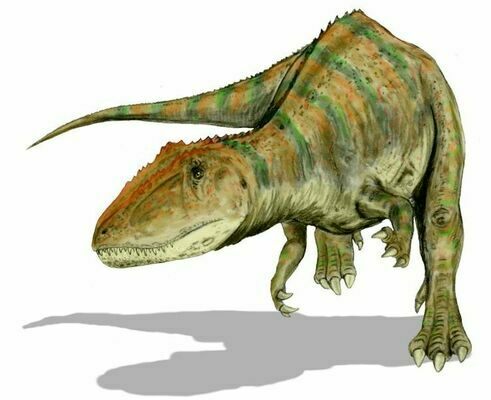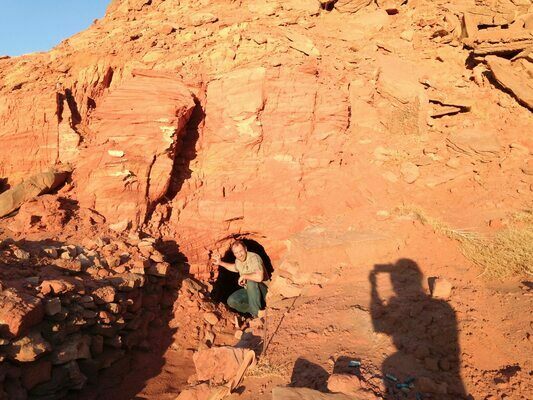This Specimen has been sold.
1.47" Carcharodontosaurus Tooth - Fine Serrations
This is a beautifully preserved, 1.47" long tooth of the massive theropod dinosaur, Carcharodontosaurus saharicus. This species often gets compared to T-Rex but is thought to have grown even larger and lived about 30 million years earlier.
This tooth has great enamel preservation, good serrations and very little feeding wear. It's much higher quality than the typical Carcharodontosaurus teeth that you see for sale.
The Kem Kem Beds are famous for yielding a diverse, Late Cretaceous, vertebrate assemblage including fish, reptiles and dinosaurs such as Spinosaurus. These fossils are found in a thin bed that outcrops around the edge of a large plateau near Taouz, Morocco. Local miners collect these fossils by digging narrow tunnels by hand into this plateau following the layer.
A paper on this assemblage can be found at: Vertebrate assemblages from the early Late Cretaceous of southeastern Morocco: An overview
This tooth has great enamel preservation, good serrations and very little feeding wear. It's much higher quality than the typical Carcharodontosaurus teeth that you see for sale.
About Carcharodontosaurus
Carcharodontosaurus comprised a genus of dinosaurs that dominated the land during the mid-Cretaceous Period, between 100-93 million years ago. This genus currently includes two gigantic species, which were among the largest known predatory dinosaurs. They were immense as the genera Tyrannosaurus and Giganotosaurus, but not as colossal as Spinosaurus.
Along with the spinosaurids, carcharodontosaurids were the largest predators in the early and middle Cretaceous throughout Gondwana, with species also present in North America (Acrocanthosaurus), and Asia (Shaochilong). Various scientists submit length estimates for C. saharicus, ranging between 12 and 13 m (39-43.5 ft) and weight estimates between 6 and 15 metric tons.
Carcharodontosaurids were a scourge of the land as giant, shark-toothed terrors in a world of monsters. Though spinosaurids would have been a formidable enemy, they may have occupied a semi-aquatic niche, which reduced competition. Both giant hunters also shared their world with menacing, 30-foot ancient crocodiles that had a taste for dinosaur.
Past the Turonian (93.9-89.8 mya), Carcharodontosaurus might have been replaced by the smaller abelisaurids in Gondwana and by tyrannosaurids in North America and Asia. The disappearance of carcharodontosaurids, spinosaurids, and other fauna in Gondwana and across the world suggests a global replacement event. Despite the event, fossils discovered in Brazil, which appear to be carcharodontosaurids, indicate some survivors of this group until the latest stage of the Cretaceous.
Carcharodontosaurus comprised a genus of dinosaurs that dominated the land during the mid-Cretaceous Period, between 100-93 million years ago. This genus currently includes two gigantic species, which were among the largest known predatory dinosaurs. They were immense as the genera Tyrannosaurus and Giganotosaurus, but not as colossal as Spinosaurus.
Along with the spinosaurids, carcharodontosaurids were the largest predators in the early and middle Cretaceous throughout Gondwana, with species also present in North America (Acrocanthosaurus), and Asia (Shaochilong). Various scientists submit length estimates for C. saharicus, ranging between 12 and 13 m (39-43.5 ft) and weight estimates between 6 and 15 metric tons.
Carcharodontosaurids were a scourge of the land as giant, shark-toothed terrors in a world of monsters. Though spinosaurids would have been a formidable enemy, they may have occupied a semi-aquatic niche, which reduced competition. Both giant hunters also shared their world with menacing, 30-foot ancient crocodiles that had a taste for dinosaur.
Past the Turonian (93.9-89.8 mya), Carcharodontosaurus might have been replaced by the smaller abelisaurids in Gondwana and by tyrannosaurids in North America and Asia. The disappearance of carcharodontosaurids, spinosaurids, and other fauna in Gondwana and across the world suggests a global replacement event. Despite the event, fossils discovered in Brazil, which appear to be carcharodontosaurids, indicate some survivors of this group until the latest stage of the Cretaceous.
The Kem Kem Beds are famous for yielding a diverse, Late Cretaceous, vertebrate assemblage including fish, reptiles and dinosaurs such as Spinosaurus. These fossils are found in a thin bed that outcrops around the edge of a large plateau near Taouz, Morocco. Local miners collect these fossils by digging narrow tunnels by hand into this plateau following the layer.
A paper on this assemblage can be found at: Vertebrate assemblages from the early Late Cretaceous of southeastern Morocco: An overview
SPECIES
Carcharodontosaurus saharicus
LOCATION
Taouz, Kem Kem Basin, Morocco
FORMATION
Kem Kem Beds
SIZE
1.47" long (straightline)
CATEGORY
SUB CATEGORY
ITEM
#18968
We guarantee the authenticity of all of our specimens.
 Reviews
Reviews
















